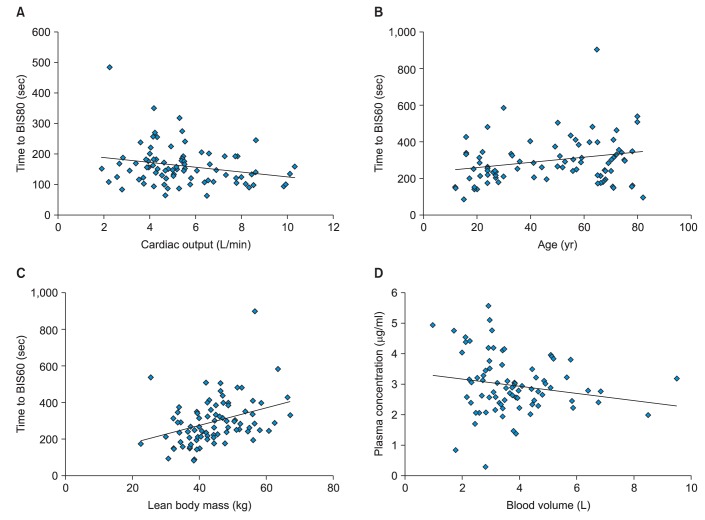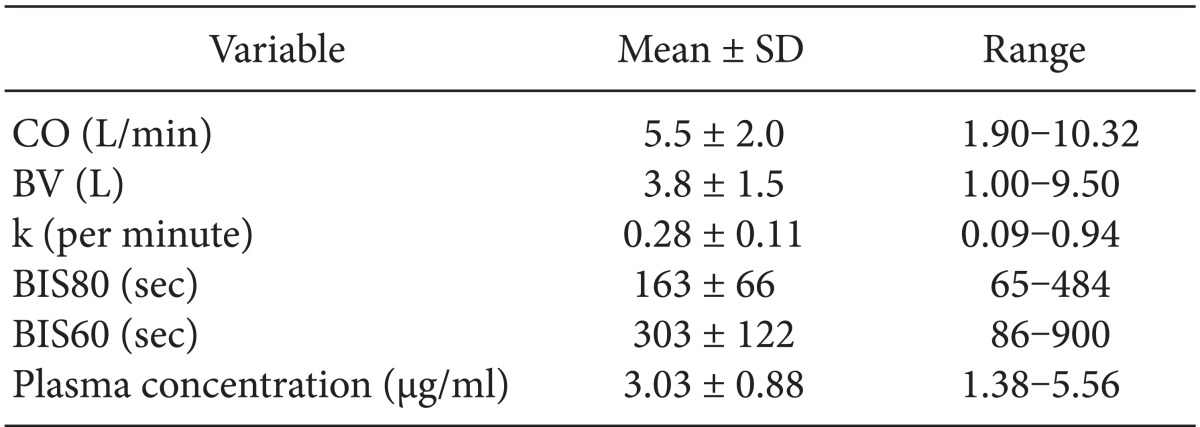1. Adachi YU, Watanabe K, Higuchi H, Satoh T. The determinants of propofol induction of anesthesia dose. Anesth Analg. 2001; 92:656–661. PMID:
11226096.

2. Kazama T, Ikeda K, Morita K, Ikeda T, Kikura M, Sato S. Relation between initial blood distribution volume and propofol induction dose requirement. Anesthesiology. 2001; 94:205–210. PMID:
11176082.

3. Adachi YU, Watanabe K, Higuchi H, Satoh T. A small dose of midazolam decreases the time to achieve hypnosis without delaying emergence during short-term propofol anesthesia. J Clin Anesth. 2001; 13:277–280. PMID:
11435052.

4. Kazama T, Ikeda K, Morita K, Kikura M, Ikeda T, Kurita T, et al. Investigation of effective anesthesia induction doses using a wide range of infusion rates with undiluted and diluted propofol. Anesthesiology. 2000; 92:1017–1028. PMID:
10754621.

5. Schnider TW, Minto CF, Gambus PL, Andresen C, Goodale DB, Shafer SL, et al. The influence of method of administration and covariates on the pharmacokinetics of propofol in adult volunteers. Anesthesiology. 1998; 88:1170–1182. PMID:
9605675.

6. Vuyk J, Engbers FH, Burm AG, Vletter AA, Griever GE, Olofsen E, et al. Pharmacodynamic interaction between propofol and alfentanil when given for induction of anesthesia. Anesthesiology. 1996; 84:288–299. PMID:
8602658.

7. Vuyk J, Oostwouder CJ, Vletter AA, Burm AG, Bovill JG. Gender differences in the pharmacokinetics of propofol in elderly patients during and after continuous infusion. Br J Anaesth. 2001; 86:183–188. PMID:
11573657.

8. Upton RN, Ludbrook GL, Grant C, Martinez AM. Cardiac output is a determinant of the initial concentrations of propofol after short-infusion administration. Anesth Analg. 1999; 89:545–552. PMID:
10475279.

9. Krejcie TC, Avram MJ. What determines anesthetic induction dose? It's the front-end kinetics, doctor! Anesth Analg. 1999; 89:541–544. PMID:
10475278.

10. Krejcie TC, Henthorn TK, Niemann CU, Klein C, Gupta DK, Gentry WB, et al. Recirculatory pharmacokinetic models of markers of blood, extracellular fluid and total body water administered concomitantly. J Pharmacol Exp Ther. 1996; 278:1050–1057. PMID:
8819485.
11. Schnider TW, Minto CF, Shafer SL, Gambus PL, Andresen C, Goodale DB, et al. The influence of age on propofol pharmacodynamics. Anesthesiology. 1999; 90:1502–1516. PMID:
10360845.

12. Kazama T, Ikeda K, Morita K, Kikura M, Doi M, Ikeda T, et al. Comparison of the effect-site ke0s of propofol for blood pressure and EEG bispectral index in elderly and younger patients. Anesthesiology. 1999; 90:1517–1527. PMID:
10360846.
13. Calvo R, Telletxea S, Leal N, Aguilera L, Suarez E, De La Fuente L, et al. Influence of formulation on propofol pharmacokinetics and pharmacodynamics in anesthetized patients. Acta Anaesthesiol Scand. 2004; 48:1038–1048. PMID:
15315624.

14. Vuyk J, Engbers FH, Burm AG, Vletter AA, Bovill JG. Performance of computer-controlled infusion of propofol: an evaluation of five pharmacokinetic parameter sets. Anesth Analg. 1995; 81:1275–1282. PMID:
7486116.
15. Haruna M, Kumon K, Yahagi N, Watanabe Y, Ishida Y, Kobayashi N, et al. Blood volume measurement at the bedside using ICG pulse spectrophotometry. Anesthesiology. 1998; 89:1322–1328. PMID:
9856705.
16. Olofsen E, Dahan A. Population pharmacokinetics/pharmacodynamics of anesthetics. AAPS J. 2005; 7:E383–E389. PMID:
16353918.

17. Kuipers JA, Boer F, Olofsen E, Bovill JG, Burm AG. Recirculatory pharmacokinetics and pharmacodynamics of rocuronium in patients: the influence of cardiac output. Anesthesiology. 2001; 94:47–55. PMID:
11135721.
18. Larsson JE, Wahlstrom G. Age-dependent development of acute tolerance to propofol and its distribution in a pharmacokinetics compartment-independent rat model. Acta Anaesthesiol Scand. 1996; 40:734–740. PMID:
8836271.
19. Ihmsen H, Schywalsky M, Tzabazis A, Schwilden H. Development of acute tolerance to the EEG effect of propofol in rats. Br J Anaesth. 2005; 95:367–371. PMID:
15980043.
20. Masui K, Kira M, Kazama T, Hagihira S, Mortier EP, Struys MM. Early phase pharmacokinetics but not pharmacodynamics are influenced by propofol infusion rate. Anesthesiology. 2009; 111:805–817. PMID:
19741485.

21. Munoz HR, Cortinez LI, Ibacache ME, Altermatt FR. Estimation of the plasma effect site equilibration rate constant (ke0) of propofol in children using the time to peak effect: comparison with adults. Anesthesiology. 2004; 101:1269–1274. PMID:
15564932.
22. Hirota K, Ebina T, Sato H, Ishihara H, Matsuki A. Is total body weight an appropriate predictor for propofol maintenance dose? Acta Anaesthesiol Scand. 1999; 43:842–844. PMID:
10492413.

23. La Colla L, Albertin A, La Colla G, Ceriani V, Lodi T, Porta A, et al. No adjustment vs. adjustment formula as input weight for propofol target-controlled infusion in morbidly obese patinets. Eur J Anaesthesiol. 2009; 26:362–369. PMID:
19307972.
24. Reekers M, Simon MJ, Boer F, Mooren RA, van Kleef JW, Dahan A, et al. Cardiovascular monitoring by pulse dye densitometry or arterial indocyanine green dilution. Anesth Analg. 2009; 109:441–446. PMID:
19608815.

25. Kazama T, Ikeda K, Morita K, Sanjo Y. Awakening propofol concentration with and without blood-effect site equilibration after short-term and long-term administration of propofol and fentanyl anesthesia. Anesthesiology. 1998; 88:928–934. PMID:
9579501.

26. Adachi YU, Higushi H. Prediction of propofol induction dose using multiple regression analysis. Anesthesiology. 2002; 96:518–519. PMID:
11818797.

27. Slinker BK, Glantz SA. Multiple regression: accounting for multiple simultaneous determinants of a continuous dependent variable. Circulation. 2008; 117:1732–1737. PMID:
18378626.






 PDF
PDF Citation
Citation Print
Print




 XML Download
XML Download